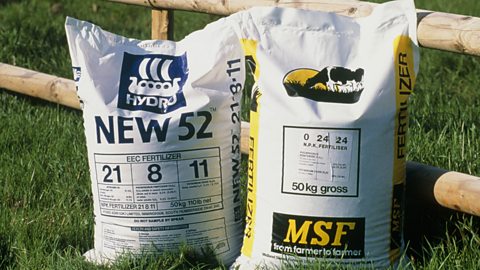What are fertilisers?
fertiliserA nutrient added to the soil to increase the soil fertility. provide mineralsNaturally occurring, inorganic chemical substances. Minerals are necessary for both plant and animal health. ionElectrically charged particle, formed when an atom or molecule gains or loses electrons. needed for healthy growth in plants. As plants grow, they absorb mineral ions from the water in the soil through their root hair cellA specialised cell that increases the surface area of the root epidermis to improve the uptake of water and minerals.. Over time, the concentrationThe concentration of a solution tells us how much of a substance is dissolved in water. The higher the concentration, the more particles of the substance are present. of these ions decreases, so farmers and gardeners add fertilisers to the soil.

Nitrogen, phosphorus and potassium
Fertilisers are formulationA mixture that is always made with the same proportions of the same substances. which may contain nitrogen, phosphorus and potassium compoundA substance formed by the chemical union of two or more elements. to promote plant growth. Fertilisers that supply all three elementA substance made of one type of atom only. are often called NPK fertilisers, after the chemical symbols for these three elements.
Fertiliser compounds must be solubleAble to dissolve in solvent. For example, sugar is soluble in water because it dissolves to form sugar solution. in water so they can be absorbed by the root hair cells:
- ammonium ions, NH4+, and nitrate ions, NO3-, are sources of soluble nitrogen
- phosphate ions, PO43-, are a source of soluble phosphorus
- all common potassium compounds dissolveWhen a substance breaks up and mixes completely with a solvent to produce a solution. in water to produce potassium ions, K+
The table shows some examples of fertilisers, their formulaA combination of symbols that indicates the chemical composition of a substance. and the essential elements they provide:
| Fertiliser | Formula | Essential element(s) |
| Ammonium nitrate | NH4NO3 | Nitrogen |
| Ammonium sulfate | (NH4)2SO4 | Nitrogen |
| Ammonium phosphate | (NH4)3PO4 | Nitrogen, phosphorus |
| Potassium nitrate | KNO3 | Potassium, nitrogen |
| Fertiliser | Ammonium nitrate |
|---|---|
| Formula | NH4NO3 |
| Essential element(s) | Nitrogen |
| Fertiliser | Ammonium sulfate |
|---|---|
| Formula | (NH4)2SO4 |
| Essential element(s) | Nitrogen |
| Fertiliser | Ammonium phosphate |
|---|---|
| Formula | (NH4)3PO4 |
| Essential element(s) | Nitrogen, phosphorus |
| Fertiliser | Potassium nitrate |
|---|---|
| Formula | KNO3 |
| Essential element(s) | Potassium, nitrogen |
Question
Urea, (NH2)2CO, is used as a fertiliser. Name the essential element it provides.
Nitrogen
The importance of ammonia in making fertilisers
Ammonia (NH3) is an alkali and when it is involved in neutralisationThe reaction between an acid and a base to form a salt plus water. reactions, it produces the ammonium ion (NH4+) which is present in lots of fertilisers.
However, ammonia can also be oxidiseChemical substances are oxidised by the addition of oxygen, removal of hydrogen or the removal of electrons. to make nitric acid (HNO3), which is the source of the nitrate ion (NO3-).
Ammonia can be neutralised by nitric acid, to make the saltThe substance formed when the hydrogen ion in an acid is replaced by a metal ion. ammonium nitrate (NH4NO3). This can be represented by the following equation:
NH3 + HNO3  NH4NO3
When this reaction takes place in aqueousDissolved in water to form a solution. Shown as (aq) in chemical equations. solution, the reaction is more correctly represented by the following equation:
Ammonium hydroxide + nitric acid  ammonium nitrate + water
NH4OH + HNO3  NH4NO3 + H2O
Mining raw materials for fertilisers
mineralsNaturally occurring, inorganic chemical substances. Minerals are necessary for both plant and animal health. are extracted from the Earth's crustThe outer shell of the surface of the planet. which can be used as fertilisers or as raw materials from which to make fertilisers.
- Potassium chloride and potassium sulfate can be used as fertilisers because they contain potassium ions.
- Phosphate rock cannot be used as a fertiliser because it is insoluble but it can be used to make fertilisers.
Phosphate rock contains phosphorus compounds. When it reacts with acids, useful soluble compounds are made:
| Phosphate rock reacts with | Compound(s) produced |
| Nitric acid | Calcium nitrate and phosphoric acid (which is neutralised with ammonia to make ammonium phosphate) |
| Sulfuric acid | Single superphosphate (a mixture of calcium sulfate and calcium phosphate) |
| Phosphoric acid | Triple superphosphate (calcium phosphate) |
| Phosphate rock reacts with | Nitric acid |
|---|---|
| Compound(s) produced | Calcium nitrate and phosphoric acid (which is neutralised with ammonia to make ammonium phosphate) |
| Phosphate rock reacts with | Sulfuric acid |
|---|---|
| Compound(s) produced | Single superphosphate (a mixture of calcium sulfate and calcium phosphate) |
| Phosphate rock reacts with | Phosphoric acid |
|---|---|
| Compound(s) produced | Triple superphosphate (calcium phosphate) |